Affordable storage for the SME, part one
by Johan De Gelas on November 7, 2007 4:00 AM EST- Posted in
- IT Computing
I/O Meter
IOMeter is an open source (originally developed by Intel) tool that can measure I/O performance in a large variety of ways: random, sequential, or a combination of the two; read, write, or a combination of the two; in blocks from a few KB to several MB, etc. IOMeter can generate the workload and measure how fast the I/O system performs. To see how close we can get to the limits of our interface, we did one test with RAID 0.
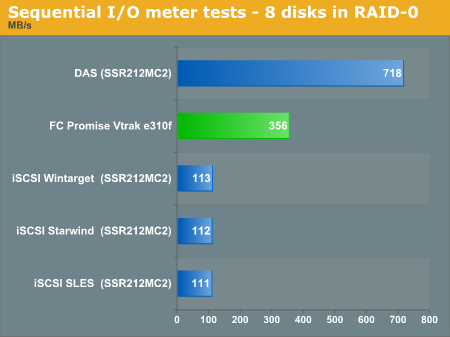
Considering that one of our Fujitsu 15000 RPM SAS disks can do a bit more than 90MB/s, 718MB/s is about the maximum performance we can expect. The iSCSI and FC Channel come close to maxing out their interface, 125MB/s and 400MB/s respectively.
Using RAID 0 for running databases is not a good practice, given the potential for data loss, so from now on we'll test with RAID 5. The next test is the fastest way to access the database: reading sequentially.
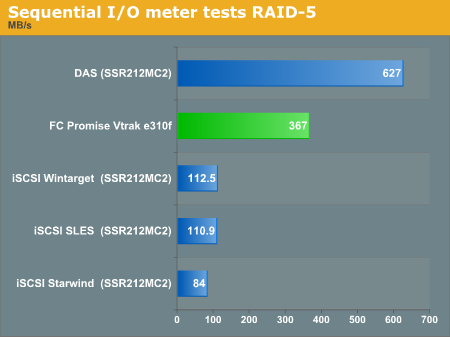
Again, the Intel IOP333 in our DAS does not let us down. Seven striped disks should achieve about 630MB/s, and our DAS configuration comes very close to this theoretical maximum. The interface speed bottlenecks the other setups. Only the StarWind target starts to shown that it's a lower performance offering.
If we read randomly, the disk array has to work a lot harder.
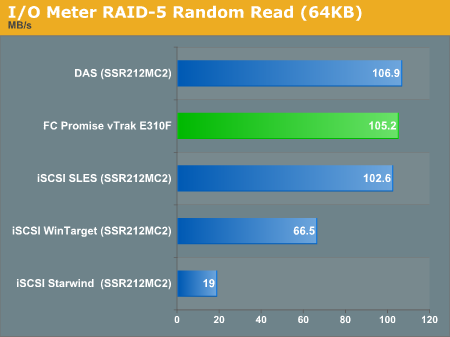
The iSCSI StarWind target gives up, as it cannot cope with a random access pattern. It performed rather badly in other tests too. To reduce the number of tests, we did not include this iSCSI target in further testing.
This is where the iSCSI SLES target shines, delivering performance that is equal to DAS and FC setups. With random accesses, it is little surprise that the larger cache of the Promise VTRAK doesn't help. However, we would have expected a small boost from the newer Intel IOP341 used in the Promise Appliance.
Some applications write a lot to the disks. What happens if we do nothing but writing sequentially or randomly?
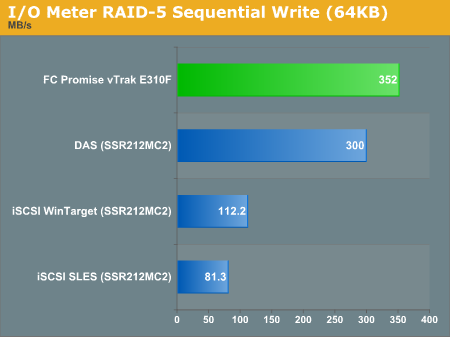
The large 512MB cache of the Promise VTRAK E310f pays off: it is capable of writing almost at the maximum speed that its 4Gb/s interface allows. The smaller 128MB cache that we find on the controller of our Intel SSR212MC2 is about 15% slower. Microsoft's iSCSI is about 38% faster in sequential writes than the iSCSI target that comes with SUSE's SLES 10 SP1.
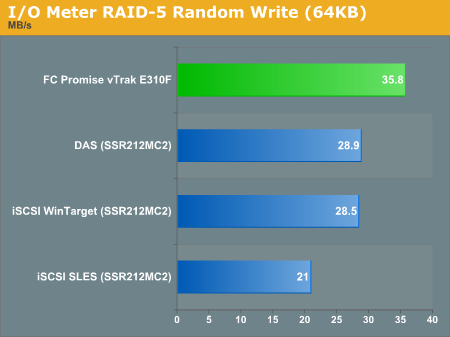
A similar advantage for the Microsoft iSCSI target exists in the random write benchmark. The way Microsoft's initiator sends off the blocks to the iSCSI target is apparently helping in this type of test. The VTRAK E310f is the winner again. This is clearly not a result of its faster interface, but probably a consequence of the newer Intel IOP processor.
An OLTP database and other applications will probably do a mix of both reading and writing, so a benchmark scenario with 66% reading and 33% writes is another interesting test.
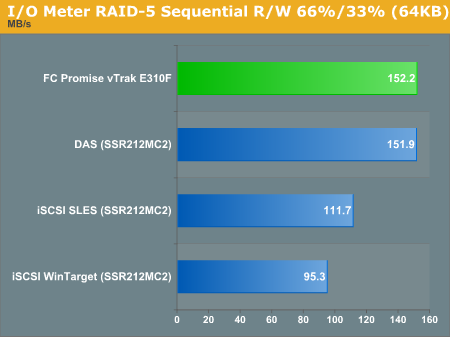
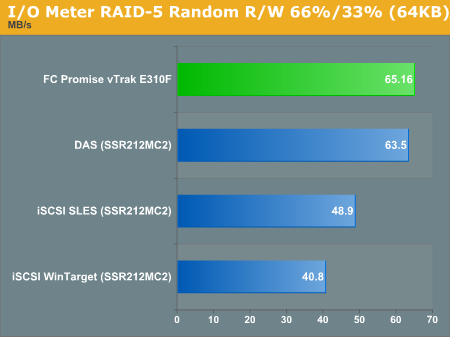
In this case, the Linux iSCSI target is about 20% faster than the Microsoft iSCSI target. The Linux iSCSI target is quicker in random reads, mixing reads with writes but a lot slower than the Microsoft target when doing nothing else but writing. It will be interesting to research this further. Does Linux have a better I/O system than Windows, especially for reads, or is the SLES iSCSI target not optimized well enough for writing? Is using a Microsoft initiator a disadvantage for the Linux iSCSI target? These questions are out of the scope of this article, but they're interesting nonetheless.
The Promise VTRAK E310f has won most of the benchmarks thanks to the larger cache and newer IOP processor. We'll update our benchmarks as soon as we can use a newer RAID controller in our Intel system based on the IOP341.
IOMeter is an open source (originally developed by Intel) tool that can measure I/O performance in a large variety of ways: random, sequential, or a combination of the two; read, write, or a combination of the two; in blocks from a few KB to several MB, etc. IOMeter can generate the workload and measure how fast the I/O system performs. To see how close we can get to the limits of our interface, we did one test with RAID 0.

Considering that one of our Fujitsu 15000 RPM SAS disks can do a bit more than 90MB/s, 718MB/s is about the maximum performance we can expect. The iSCSI and FC Channel come close to maxing out their interface, 125MB/s and 400MB/s respectively.
Using RAID 0 for running databases is not a good practice, given the potential for data loss, so from now on we'll test with RAID 5. The next test is the fastest way to access the database: reading sequentially.

Again, the Intel IOP333 in our DAS does not let us down. Seven striped disks should achieve about 630MB/s, and our DAS configuration comes very close to this theoretical maximum. The interface speed bottlenecks the other setups. Only the StarWind target starts to shown that it's a lower performance offering.
If we read randomly, the disk array has to work a lot harder.

The iSCSI StarWind target gives up, as it cannot cope with a random access pattern. It performed rather badly in other tests too. To reduce the number of tests, we did not include this iSCSI target in further testing.
This is where the iSCSI SLES target shines, delivering performance that is equal to DAS and FC setups. With random accesses, it is little surprise that the larger cache of the Promise VTRAK doesn't help. However, we would have expected a small boost from the newer Intel IOP341 used in the Promise Appliance.
Some applications write a lot to the disks. What happens if we do nothing but writing sequentially or randomly?

The large 512MB cache of the Promise VTRAK E310f pays off: it is capable of writing almost at the maximum speed that its 4Gb/s interface allows. The smaller 128MB cache that we find on the controller of our Intel SSR212MC2 is about 15% slower. Microsoft's iSCSI is about 38% faster in sequential writes than the iSCSI target that comes with SUSE's SLES 10 SP1.

A similar advantage for the Microsoft iSCSI target exists in the random write benchmark. The way Microsoft's initiator sends off the blocks to the iSCSI target is apparently helping in this type of test. The VTRAK E310f is the winner again. This is clearly not a result of its faster interface, but probably a consequence of the newer Intel IOP processor.
An OLTP database and other applications will probably do a mix of both reading and writing, so a benchmark scenario with 66% reading and 33% writes is another interesting test.


In this case, the Linux iSCSI target is about 20% faster than the Microsoft iSCSI target. The Linux iSCSI target is quicker in random reads, mixing reads with writes but a lot slower than the Microsoft target when doing nothing else but writing. It will be interesting to research this further. Does Linux have a better I/O system than Windows, especially for reads, or is the SLES iSCSI target not optimized well enough for writing? Is using a Microsoft initiator a disadvantage for the Linux iSCSI target? These questions are out of the scope of this article, but they're interesting nonetheless.
The Promise VTRAK E310f has won most of the benchmarks thanks to the larger cache and newer IOP processor. We'll update our benchmarks as soon as we can use a newer RAID controller in our Intel system based on the IOP341.










21 Comments
View All Comments
Anton Kolomyeytsev - Friday, November 16, 2007 - link
Guys I really appreciate you throwing away StarWind! W/o even letting people know what configuration did you use, did you enable caching, did you use flat image files, did you map whole disk rather then partition, what initiator did you use (StarPort or MS iSCSI), did you apply recommended TCP stack settings etc. Probably it's our problem as we've managed to release the stuff people cannot properly configure but why did not you contact us telling you have issues so we could help you to sort them out?With the WinTarget R.I.P. (and MS selling it's successor thru the OEMs only), StarWind thrown away and SANmelody and IPStor not even mentioned (and they are key players!) I think your review is pretty useless... Most of the people are looking for software solutions when you're talking about "affordable SAN". Do you plan to have second round?
Thanks once again and keep doing great job! :)
Anton Kolomyeytsev
CEO, Rocket Division Software
Johnniewalker - Sunday, November 11, 2007 - link
If you get a chance, it would be great to see what kind of performance you get out of an iscsi hba, like the one from qlogic.When it gets down to it, the DAS numbers are great for a baseline, but what if you have 4+ servers running those io tests? That's what shared storage is for anyhow. Then compare the aggregate io vs DAS numbers?
For example, can 4 servers can hit 25MB/s each in the SQLio random read 8kb test for a total of 100MB/s ? How much is cpu utilization reduced with one or more iscsi hba in each server vs the software drivers? Where/how does the number of spindles move these numbers? At what point does the number of disk overwhelm one iscsi hba, two iscsi hba's, one FC hba, two FC hbas, and one or two scsi controllers?
IMHO iscsi is the future. Most switches are cheap enough that you can easily build a seperate dedicated iscsi network. You'd be doing that if you went with fiber channel anyhow, but at a much higher expense (and additional learning curve) if you don't already have it, right?
Then all we need is someone who has some really nice gui to manage the system - a nice purdy web interface that runs on a virtual machine somewhere, that shows with one glance the health, performance, and utilization of your system(s).
System(s) have Zero faults.
Volume(s) are at 30.0 Terabytes out of 40.00 (75%)
CPU utilization is averaging 32% over the last 15 minutes.
Memory utilization is averaging 85% over the last 15 minutes.
IOs peaked at 10,000 (50%) and average 5000 (25%) over the last 15 minutes.
Pinch me!
-johhniewalker
afan - Friday, November 9, 2007 - link
You can get one of the recently-released 10Gbps PCI-E TCP/IP card for <$800, and they support iSCSI.here's one example:
http://www.intel.com/network/connectivity/products...">http://www.intel.com/network/connectivi...oducts/p...
The chip might be used by Myricom and others, (I'm not sure), and there's a linux and a bsd driver - a nice selling point.
10gb ethernet is what should really change things.
They look amazing on paper -- I'd love to see them tested:
http://www.intel.com/network/connectivity/products...">http://www.intel.com/network/connectivi...ucts/ser...
JohanAnandtech - Saturday, November 10, 2007 - link
The problem is that currently you only got two choices: expensive CX4 copper which is short range (<15 m) and not very flexible (it is a like infiniband cables) or Optic fiber cabling. Both HBAs and cables are rather expensive and require rather expensive switches (still less than FC, but still). So you the price gap with FC is a lot smaller. Of course you have a bit more bandwidth (but I fear you won't get much more than 5 GBit, has to be test of course), and you do not need to learn fc.Personally I would like to wait for 10 gbit over UTP-cat 6... But I am open to suggestion why the current 10 gbit would be very interesting too.
afan - Saturday, November 10, 2007 - link
Thanks for your answer, J.first, as far as I know, CX4 cables aren't as cheap as cat_x, but they aren't all _that_ expensive to be a showstopper. If you need more length, you can go for the fibre cables -- which go _really_ far:
http://www.google.com/products?q=cx4+cable&btn...">http://www.google.com/products?q=cx4+ca...amp;btnG...
I think the cx4 card (~$800)is pretty damn cheap for what you get: (and remember it doesn't have pci-x limitations).
Check out the intel marketing buzz on iSCSI and the junk they're doing to speed up TCP/IP, too. It's good reading, and I'd love to see the hype tested in the real world.
I agree with you that UTP-cat 6 would be much better, more standardized, much cheaper, better range, etc. I know that, but if this is we've got now, so be-it, and I think it's pretty killer, but I haven't tested it : ).
Dell, cisco, hp, and others have CX4 adapters for their managed switches - they aren't very expensive and go right to the backplane of the switch.
here are some dell switches that support CX-4, at least:
http://www.dell.com/content/products/compare.aspx/...">http://www.dell.com/content/products/co...er3?c=us...
these are the current 10gbe intel flavors:
copper: Intel® PRO/10GbE CX4 Server Adapter
fibre:
Intel® PRO/10GbE SR Server Adapter
Intel® PRO/10GbE LR Server Adapter
Intel® 10 Gigabit XF SR Server Adapters
a pita is the limited number of x8 PCI-E slots in most server mobos.
keep up your great reporting.
best, nw
somedude1234 - Wednesday, November 7, 2007 - link
First off, great article. I'm looking forward to the rest of this series.From everything I've read coming out of MS, the StorPort driver should provide better performance. Any reason why you chose to go with SCSIPort? Emulex offers drivers for both on their website.
JohanAnandtech - Thursday, November 8, 2007 - link
Thanks. It is something that Tijl and myself will look into, and report back in the next article.Czar - Wednesday, November 7, 2007 - link
Love that anandtech is going into this direction :DRealy looking forward to your iscsi article. Only used fiber connected sans, have a ibm ds6800 at work :) Never used iscsi but veeery interested into it, what I have heard so far is that its mostly just very good for development purposes, not for production enviroments. And that you should turn of I think chaps or whatever it its called on the switches, so the icsci san doesnt overflow the network with are you there when it transfers to the iscsi target.
JohanAnandtech - Thursday, November 8, 2007 - link
Just wait a few weeks :-). Anandtech IT will become much more than just one of the many tabs :-)
We will look into it, but I think it should be enough to place your iSCSI storage on a nonblocking switch on separate VLAN. Or am I missing something?
Czar - Monday, November 12, 2007 - link
think I found ithttp://searchstorage.techtarget.com/generic/0,2955...">http://searchstorage.techtarget.com/generic/0,2955...
"Common Ethernet switch ports tend to introduce latency into iSCSI traffic, and this reduces performance. Experts suggest deploying high-performance Ethernet switches that sport fast, low-latency ports. In addition, you may choose to tweak iSCSI performance further by overriding "auto-negotiation" and manually adjusting speed settings on the NIC and switch. This lets you enable traffic flow control on the NIC and switch, setting Ethernet jumbo frames on the NIC and switch to 9000 bytes or higher -- transferring far more data in each packet while requiring less overhead. Jumbo frames are reported to improve throughput as much as 50%. "
This is what I was talking about.
Realy looking forward to the next article :)